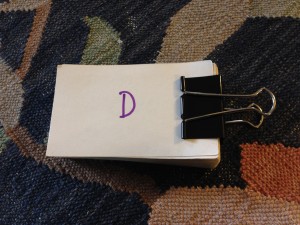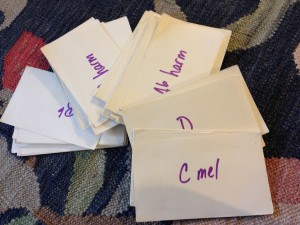Game for scales- major, minor, and chromatic
- Marlene
- Blog, flute, Uncategorized
- 4 Comments
Game for scales- major, minor, and chromatic
Scales can be mindlessly boring… or scales can be tolerable.
(If I said playing scales was the most exciting thing in the world, you would know I was lying and you wouldn’t read another word.)
Practicing scales is a bit like taking medicine- it doesn’t taste good, but the results are worth it.
In this blog post, I’m going to give you a game that you can play with scales. In no time you will have mastered all your major and minor scales plus the chromatic scale. Maybe you will find that playing scales this way is more pleasant than drinking cherry cough syrup.
We’re going to trick your brain into thinking that scales are fun. There’s a random element in the game that takes the pressure off of you to make decisions.
What you will need: 50 blank note cards, a marker, a large rubber band or binder clip.
Step 1: Make 12 cards, one for each of the major scales. Write in bold letters in the center of a note card C Major. Repeat with the other 11 major scales, the names of which you will find on the outside (red letters) of the Circle of Fifths wheel below. Make sure you write the name of the scale and word “Major” with a capital letter at the beginning. It’s a music theory thing.
Step 2: Make the minor scale cards. This is the tricky part because each minor scale has three versions: natural, harmonic, and melodic. Your first three cards will be “a minor, natural,” “a minor, harmonic,” and “a minor, melodic.” Refer to the inside (green letters) of the Circle of Fifths wheel below for the other 11 names of the minor scales. Make sure you have three for each letter. Writing minor scales in all lowercase letters is also a music theory thing. When you are finished, you should have a total of 36 minor cards.
Step 3: Take the remaining 2 scale cards and write CHROMATIC on them. You don’t have to write it in all caps. Be crazy and write it in all lowercase if it suits you. It’s not a music theory thing.
Now you have a stack of 50 note cards with the name of scales written on one side. You’ll want to keep them together using a large rubber band or binder clip. These pictures show the scale cards I made in 1993 with my teacher Tom Kennedy. I used these cards to learn scales for my college auditions, and I still use them today!
Now that you have made your scale cards, you are ready to play the game!
You are going to create two piles of cards. One will be the “BRAVO” pile for all the scales you can play correctly the first time and the other pile will be the “deck.” Shuffle the cards and close your eyes while you pick three cards from the deck. Play the first scale. Did you play all the notes correctly with a beautiful tone and the correct fingering? If yes, place that scale card in the “BRAVO” pile. If it wasn’t perfect, place the scale card back in the deck with the others. Do the same thing with the two other scales. Your goal is to get all the cards into the “BRAVO” pile.
Tomorrow, pick three more cards from the deck, remembering that you might draw the ones you missed today. When all of the cards are in the “BRAVO” pile, re-shuffle the whole deck and work through them again. Perhaps this time you can get through the entire deck faster.
If you haven’t learned all of your major and minor scales yet, you can play this game with the ones you know. Totally confused about how to play scales? There are many good books to use for a reference. For flute, I recommend The Flute Scale Book and The Flutist’s Vade Mecum. Find a book for your instrument, or search online.
It’s best if you can play the scales from memory, but if you need to use the music for awhile, that’s OK. As you learn more scales, add them to the pile until you are using all 50.
When you’re ready for the next level of difficulty, try playing the scales with different articulation patterns (Articulation Game) and rhythms.
Scales are an important part of every musician’s technique. They are required in competitions and auditions. Learn them now; use them forever!
Happy practicing!



Sounds like a good plan. I’ll have to remember this one.
Thanks for reading, Kathleen.